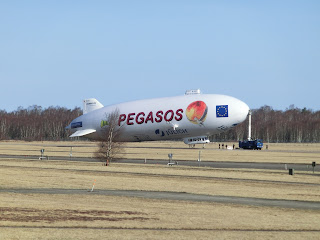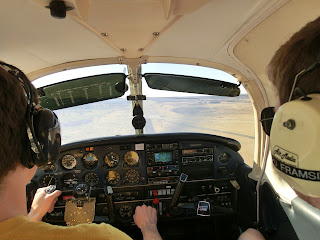The last
few weeks have been quite intense ones! We have had every other week of theory
studies and flying respectively. This block of theory studies consists of Mass
and balance, Operational procedures and Instrumentation. Mass and balance is
one of the subjects that is most useful for everyday life as a commercial pilot
– since pilots before every flight have to calculate the total weight and
centre of gravity of the loaded plane and verify that they are within the
limits. Operational procedures is about rules and regulations – from a little
more practical point of view than the similar subject Airlaw. Instrumentation
is about the instruments in cockpit and is one of the largest theory subjects.
The last flight lessons consisted of practicing the most important parts we've learnt since we began flying and showing for a school instructor that we are ready for the practical exam at Transportstyrelsen. He decided that I was indeed ready, why I had one last chance to practice by myself the things I thought I needed the most, and after that I could take the real exam – which I passed without problems. The school is known to be harsh and not let students do the exam too early, why it's quite rare that students fail the real one.
The last flight lessons consisted of practicing the most important parts we've learnt since we began flying and showing for a school instructor that we are ready for the practical exam at Transportstyrelsen. He decided that I was indeed ready, why I had one last chance to practice by myself the things I thought I needed the most, and after that I could take the real exam – which I passed without problems. The school is known to be harsh and not let students do the exam too early, why it's quite rare that students fail the real one.
The licence that I've now obtained is a Private Pilot's Licence (PPL), with a Single Engine Piston Land (SEP(L)) rating, which allows me to non-commercially fly piston engine propeller airplanes with only one engine and only on land (=not on water). Other licences are among others Commercial Pilot's Licence (CPL), Multi-crew Pilot's Licence (MPL), Ultralight aircraft pilot's licence etc. These must then be combined with a rating, and there are a lot of ratings – including Multi engine piston, Turboprop, Motor glider, Instrument flying rating and individual Type ratings for most larger aircraft (one rating for a Boeing 737, another for 747, 757 etc.). Then you'll need differences training for retractable gear, modern instruments, different wheel types and more. It's an infinite collector's sport.
Almost immediately after passing the exam I contacted the local flying club here in Ljungbyhed about membership in order to be able to rent an airplane and fly whenever I want. Costs for flying in a club vary a lot but this one is a little cheaper than most clubs in Sweden. The yearly member fee is 1205 SEK. It is also a fairly large club having seven airplanes of six types at members' disposal: two Piper PA-28 (a -161 and a -181), a Piper PA-32, a Diamond DA-40, a Pierre Robin DR400, an Evektor 97 Eurostar and a Saab 91 Safir. I decided to begin with flying the PA-28s doing a roughly 80 minutes differences training flight lesson with an instructor – so now I'm ready to fly as much as my wallet permits! Rent is 1060 SEK/hour and 1240 SEK/hour respectively for those planes – the more expensive one is much newer (2001 year model, compared to 1977). However I only pay for the time actually flying and every five minutes are counted.
The PA-28 after having been in production since 1960 and still is, have become the second most produced civilian airplane in history (number one is Cessna 172). It has four seats but the engine is not near powerful enough for four adults and full tanks – so in practice it carries two to four persons depending on their body weight and how much fuel is carried. This is perfectly normal for a plane of this size. Speed is around 200 km/h. With 180 liters of fuel (full tanks) it can fly for around 6 hours and a distance of 1200 km. That gives a fuel consumption of roughly 14 liters per 100 km. While it's certainly not the most environmental friendly pastime one can have, I doubt that an average car would consume less fuel, if you drive at a speed of 200 km/h...
Photos:
On a weekend recently a German airship visited Ljungbyhed on its way to Skavsta - really cool! While one would think that airships are fairly environmental-friendly and not the least this one doing climate research, but in fact it is always followed by a caravan of cars on the ground including a truck acting the docking point for the airship – obviously that's very important since most cities lack an airport suited for airships nowadays...
Me and my classmate Martin flying the PA-28 at the flight club. In the second picture Martin is flying the newer PA-28-181 and in the last picture I'm flying the older PA-28-161.
A landing with the same newer PA-28-181
Very recently our friends in the class above us – TFHS11 – passed their practical tests and obtained a commercial pilot's license – an MPL. Soon after that they boarded a real Boeing 737-800 (the training and tests up to this point have all been in a simulator) and did 12 touch and go landings at one occasion which is the final part of the training before you are allowed to fly an airliner with passengers. Me and some classmates went by car to nearby Kristianstad airport in order to watch their touch and go training from the airport tower – really nice! Good luck to them in their internship flying as real pilots for Norwegian, starting now!





